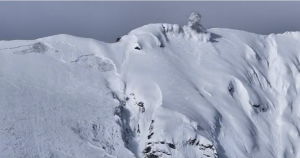22 November 2016
Avalanches more complex than previously thought
Posted by dgaristo
New study observes inner workings of avalanche with innovative technology
By Dan Garisto
Avalanches can throw up a powdery cloud of snow as they violently charge down mountains, obscuring their inner workings from scientists.

The artificial triggering of an avalanche at the Vallée de la Sionne, in Switzerland, uses explosives to disrupt the pack of snow. Credit: Swiss Federal Institute for Snow and Avalanche Research
But new observations of artificially-triggered avalanches in Switzerland’s Vallée de la Sionne have penetrated this powdery veil. Scientists used an innovative radar system, sensors on a pylon and video equipment to get perhaps the best look at avalanches yet.
They report in a new study that avalanches have a more complex internal structure than previously known. The new study finds rather than being one mass of snow, avalanches are made up of many internal surges that can overtake each other as the avalanche gathers snow and moves downhill.
Understanding avalanche mechanics is important for predicting their potential path, which could help mitigate their destruction, according to the study’s authors. Avalanches kill about 100 people every year in the European Alps alone and those near infrastructure can cause millions of dollars in damage.
The new study, published in the Journal of Geophysical Research: Earth Surface, a journal of the American Geophysical Union, is one of the first to probe the internal structure of avalanches in this detail, according to the study’s authors.
“It is changing the view we have on avalanches,” said Anselm Köhler, a Ph.D. student at the Swiss Federal Institute for Snow and Avalanche Research in Davos, Switzerland, and Durham University in the United Kingdom.
“If you were just thinking of some mass going down the mountain, you would say ‘Well it has a front and it has a tail and it comes down.’ But what this radar shows is that there is a much more complicated internal structure,” said Köhler, lead author of the new research that was also featured in a recent BBC special on avalanches.
Going downhill
Avalanches are spawned by disruptions to huge masses of packed, unstable snow, and in the Alps, they can reach speeds of about 200 kilometers (125 miles) per hour. A prime location for studying avalanches and the mechanics driving them is the snowy Vallée de la Sionne in southwestern Switzerland.
There, researchers use various equipment to observe avalanche dynamics and measure properties such as speed, direction and pressure. However, naturally-caused avalanches are unpredictable and hard to observe during their short lifespans.
To get around this, researchers use explosives to artificially trigger an avalanche. In the new study, Köhler and his colleagues artificially triggered five avalanches in the Vallée de la Sionne and observed them with state-of-the-art equipment.
In the past, researchers have used Doppler radar to detect an avalanche’s speed under the powder cloud. However, Doppler radar has poor resolution, preventing it from seeing an avalanche’s internal structures, which are areas where snow is more densely packed. GEODAR, an avalanche-specific radar used in the new study, is able to observe the location of internal structures in the avalanche at a high resolution.
“Most of the dynamics happens below the powder cloud, so we have to use some device to penetrate through the cloud,” Köhler said. By combining video analysis with radar images, the researchers could see different portions of the powder cloud in each avalanche and the snow flowing beneath them.
What they found was striking: The avalanches were not just single masses of smoothly moving snow. Rather, the avalanches contained multiple internal surges of snow moving at very different speeds.
Frequently, these internal surges overtook the leading edge of the avalanche, a phenomenon not accounted for by current models.
“We had this idea that it happened, but it was never shown so clearly,” said Dieter Issler, a physicist at the Norwegian Geotechnical Institute in Oslo, who was not involved with the new study. “[The new study] is really a quantum leap in the possibilities of studying the internals of snow avalanches.”
One of the possible reasons behind the different surge speeds is a difference in friction—some parts of the avalanche have greater contact with the ground than others, Köhler said. Where there is greater friction, the avalanche slows down.
Köhler and his colleagues plan to probe avalanches more deeply in the future, adding lateral views of avalanches that would allow for an extra dimension of study into the mysteries beneath the powder. A better understanding of these surges and other avalanche mechanics could help scientists improve their ability to model avalanches and predict their paths, according to the study’s authors.
“This study emphasizes and shows in a clear and graphical manner how complex snow avalanches can be and usually are,” Issler said. “Despite this enormous complexity… there is hope that with good instrumentation and ingenious experimentation methods, we can start to unravel even fine details of the dynamics and have a better understanding how snow avalanches … show more complexity.”
—Dan Garisto is a science writing intern at the American Geophysical Union.


 GeoSpace is a blog on Earth and space science, managed by AGU’s Public Information staff. The blog features posts by AGU writers and guest contributors on all sorts of relevant science topics, but with a focus on new research and geo and space sciences-related stories that are currently in the news.
GeoSpace is a blog on Earth and space science, managed by AGU’s Public Information staff. The blog features posts by AGU writers and guest contributors on all sorts of relevant science topics, but with a focus on new research and geo and space sciences-related stories that are currently in the news.